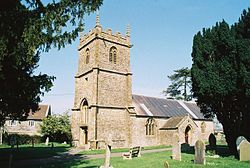Leigh, Dorset
| Leigh | |
| Dorset | |
|---|---|
 Parish church of St Andrew | |
| Location | |
| Grid reference: | ST619086 |
| Location: | 50°52’32"N, 2°32’40"W |
| Data | |
| Population: | 480 (2011) |
| Post town: | Sherborne |
| Postcode: | DT9 |
| Local Government | |
| Council: | Dorset |
| Parliamentary constituency: |
West Dorset |
| Website: | Leigh Village |
Leigh is a village in Dorset, situated approximately five miles south of Sherborne. It is known as the site of a former Miz Maze. The 2011 census recorded a parish population of 480.
History

One mile south-east of the village is a 10-acre enclosure called 'The Castle'. The physical remnants on the ground indicate the previous existence of a castle here, although there are no historical records for the site.[1]
Leigh has a village cross with a shaft dating from the 15th century.
The parish church, dedicated to St Andrew, was previously a chapel of neighbouring Yetminster. It also dates from the 15th century, though was substantially altered—including the virtual rebuilding of the chancel—in 1854.[2][3]
Miz Maze
In a field just south of the village are the remains of a turf labyrinth or "Miz Maze", an earthwork of uncertain origin that, centuries ago, may have been used for spiritual meditation and as a meeting place. The labyrinth was laid out on banks and in the 17th century was re-cut every year by the young men of the village.[2] It was described in 1815 in the second edition of John Hutchins's 'History of Dorset':
On an eminence in the common, about a quarter of a mile south from the village, is a maze of circular form, surrounded by a bank and ditch, and occupying an eighth part of an acre. The banks of earth of which it is composed are set almost close together, and are somewhat more than one foot in width and about half a foot in height.
Depositions from 1650–1664 state that the Miz Maze is where local witches used to meet.[4] In 1879 the Dorset dialect poet William Barnes presented the Dorset Field Club with a paper in which he wrote "Many years ago I was told by a man of this neighbourhood that a corner of Leigh Common was called 'Witches Corner'; and long after that a friend gave me some old depositions on witchcraft ... one of the witches' sisterhood said that they sometimes met in Leigh Common."[2] The last witch to be burned in England was reputed to have been arrested at a conference here in the 17th century and then executed at Maumbury Rings in Dorchester.[2][4]
There used to be several of these labyrinths in Dorset, though this is the only one where traces still remain,[4] and even here there is little evidence except for small disturbances in the grass surface which can be felt underfoot.
Geography

Leigh sits in the Blackmore Vale, and measured directly, the village is five miles south-southwest of Sherborne, six miles south-east of Yeovil and twelve miles north-northwest of the county town Dorchester.
The surrounding landscape is gently undulating and predominantly agricultural. The underlying geology is Oxford clay which here produces good quality pasture; the village was once known for producing cheese and cider, with at one time every farm possessing an orchard.[5] One mile to the west of the village is the small Wriggle River, which drains into the River Yeo. Approximately two and a half miles to the south are the chalk hills of the Dorset Downs.
Outside links
| ("Wikimedia Commons" has material about Leigh, Dorset) |
References
- ↑ M A Rodger (February 2009). "Some Lost Castles of Dorset". Dorset Life Magazine. http://www.dorsetlife.co.uk/2009/02/some-lost-castles-of-dorset/. Retrieved 18 February 2014.
- ↑ 2.0 2.1 2.2 2.3 Roland Gant (1980). Dorset Villages. Robert Hale Ltd. p. 69. ISBN 0 7091 8135 3.
- ↑ Leigh, Dorset: An Inventory of the Historical Monuments in Dorset, Volume 1, pages 130–132
- ↑ 4.0 4.1 4.2 West Dorset, Holiday and Tourist Guide. West Dorset District Council. c. 1983. p. 10.
- ↑ Ralph Wightman (1983). Portrait of Dorset (4 ed.). Robert Hale Ltd. pp. 18, 140. ISBN 0 7090 0844 9.
